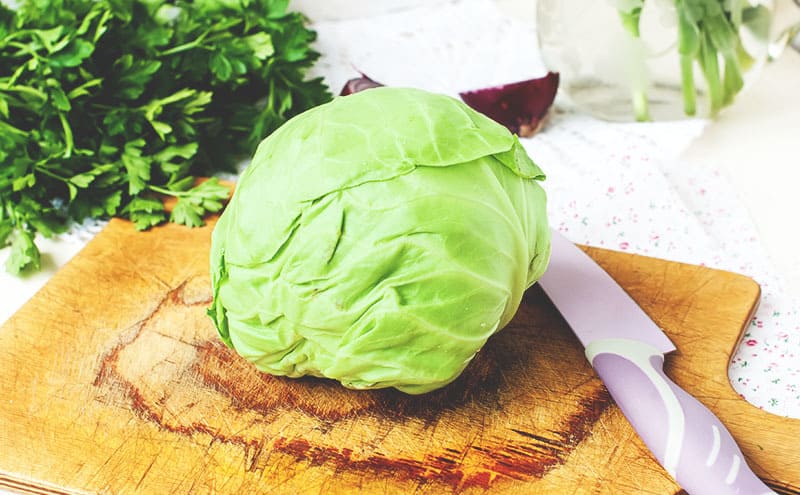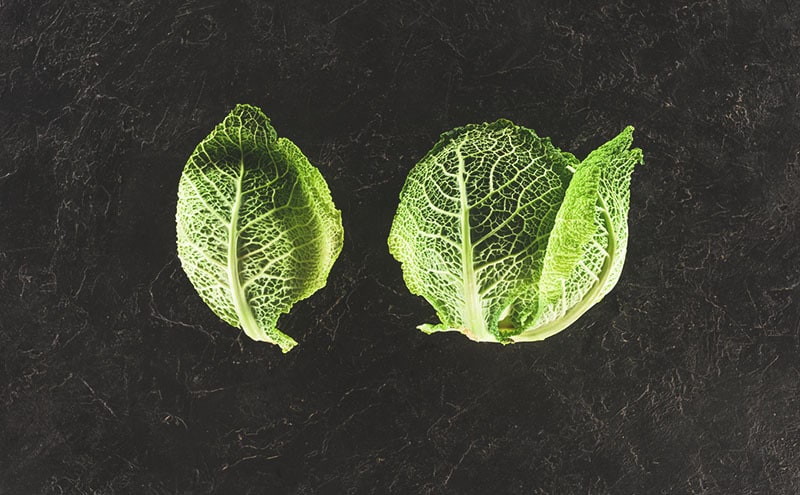
At a Glance
- Cabbage is a cruciferous vegetable with a neutral taste. It contains 90% water, making it perfect for juicing.
- Cabbage contains vitamins A, B,C, E, K and U, adequate amounts of potassium, iron, calcium, manganese and magnesium along with the isothiocyanate family of phytochemicals and indole-3-carbinol
- Cabbage juice benefits for health may include antioxidant and anti-inflammatory effects, boosting immunity, antifungal properties, lowering cholesterol, fighting cancer and memory loss and healing peptic ulcers
Cabbage is one of the oldest known cruciferous vegetables, dating back to 4000 B.C. in China. Modern day cabbage has been cultivated for at least 7000 years, starting out in Europe and spreading to Asia and the Americas.
Used by many cultures throughout history, the ancient Romans loved cabbage and used it for many purposes, including medicine.
Used a lot in traditional folk medicine, modern research has proven cabbage is very beneficial to human health.
The hearty cabbage is the national food of Russia! Every year Russians eat more than seven times more cabbage than the average American.
In this article, we take a look at the wide array of cabbage juice benefits for health and how best to use it when juicing.
What’s in a Cabbage?
This vegetable is a storehouse of vitamins and minerals containing fiber, vitamins A, B,C, E, K and U, adequate amounts of potassium, iron, calcium, manganese and magnesium (source). Cabbage is low in calories and fat. Cabbage leaves can be slightly sweet or slightly bitter in taste.
Cabbage, like all vegetables, contains phytochemicals – naturally occurring protective compounds with health promoting properties. There are over 1000 known phytochemicals and cabbage’s most important are isothiocyanates and indole-3-carbinol.
Isothiocyanates are antioxidants that help elimination of toxins. Indole-3-carbinol is anti-carcinogenic. Red cabbage is a winner when it comes to antioxidants as it contains anthocyanin (not found in green cabbage). This phytochemical gives red cabbage its colour and has strong anti inflammatory and antibacterial actions.
Cabbage Contains Antioxidants
Foods that are high in antioxidants are an amazing defence against harmful free radicals and may help fight cancer and heart disease.
All cabbages contain vitamin A and an enormous amount of vitamin C (more than oranges!). Both of these are some of the most powerful antioxidant vitamins in the body, giving the immune system a boost.
Research has shown that Chinese cabbages are a great source of antioxidants. (source)
Cabbages Have Anti-inflammatory Properties
Cabbage can reduce the effects of many types of inflammation, joint pain, allergies and various skin disorders.
Inflammation fighting phytonutrients, namely anthocyanins, make red cabbage a standout anti-inflammatory food. (sources 1, 2) That said, all types of cabbage contain significant amounts of polyphenols with anti-inflammatory benefits.
Cabbage can Help Boost Immune Health
Red coloured foods seem to have more health benefits than green, and it’s no different with cabbage. The red cabbage has plant based-polyphenols which are capable of boosting immune health.
That red-purple pigmentation in red cabbage is a result of anthocyanins. These compounds have been studied and shown to play a significant role in preventing diseases such as cancer, diabetes and neurological diseases. (source)
Cabbage Fights Bacteria
Many illnesses are foodborne, and some of these illnesses are caused by bacteria. Cabbage’s anti-bacterial properties and sulphur-based compounds are ideal for killing all types of harmful bacteria.
Research shows that the juice from Brassica oleracea leaf – a type of cabbage – may play a role in preventing bacterial growth. Results confirmed the leaf juice inhibited growth of bacteria, including salmonella and E. coli. (source)
Antifungal Properties of Cabbage
Everyone has Candida albicans in their gut, but it becomes a problem if it grows out of control. Overgrowth of this yeast fungus most commonly causes thrush infection.
Cabbage juice has been shown to inhibit the reproduction and overgrowth of candida albicans, and inhibited the growth of other fungi as well (sources 1, 2)
Cabbage Helps Lower Cholesterol
Cabbage helps lower levels of low-density lipoprotein (LDL), referred to as ‘bad’ cholesterol. Red cabbage, which is high in omega-3 essential fatty acids, showed more potency than green cabbage.
Research has shown improvement in LDL cholesterol levels after following a diet that included raw red cabbage. Participants consumed 300g of red cabbage daily for two weeks, results were a decrease in total cholesterol and LDL cholesterol. (source)
Another study in Japan over 12 weeks showed an 8% reduction in total cholesterol from drinking cabbage juice. (source)
Cabbage Helps Fight Cancer
Cabbage contains potent anti-cancer compounds called isothiocyanates. These up the body’s natural detoxification systems. As with most cruciferous vegetables, cabbage can boost the body’s resistance to cancers. (sources 1, 2) Research supports the theory that phytochemical indole-3-carbinol found in cabbage can prevent and slow growth of cancer cells. (source)
A human study in China involving patients with stomach cancer and a control group showed Chinese cabbage plays an important role in reducing the risk of stomach cancer. (source)
Another study looked at the benefits of both cooked and raw cabbage to inhibit cancer cell growth. It determined that raw was indeed the best way to consume cabbage, as cooking greatly reduced the plant’s phytochemical content. (source)
Cabbage Helps Fight Breast Cancer
Globally, breast cancer now represents one in four of all cancers in women. Breast cancer is the most common cancer in women worldwide. (source)
In a study from Poland, an impressive reduction in breast cancer risk was observed in women consuming large amounts of cabbage (at least four servings per week). (source)
Cabbage May Help Memory Loss
The antioxidants in cabbage can slow oxidative stress, a process involved in the brain’s aging process. Red cabbage contains even higher levels of anti-inflammatory pigments.
Anthyrocilin, lycopene and vitamin K help fight memory loss and have been found to limit neuronal damage in the brain in Alzheimer’s disease. (source)
In a study of both men and women, a diet that included cabbage was linked to better cognitive function. (source)
Cabbage Can Help Peptic Ulcers
Stomach ulcers, also known as gastric or peptic ulcers, are open sores in the lining of the stomach. Ulcers are very common ailment for which cabbage may be an excellent natural treatment.
Cabbage contains an antipeptic ulcer factor known as vitamin U which strengthens your stomach lining and increases resistance to ulcers. Cabbage is one of the best natural antacids due to its glutamine content. Raw cabbage juice targets h.pylori bacteria often associated with stomach ulcers.
Early studies showed the effectiveness of raw cabbage juice in treating peptic ulcers. In comparison to conventional drug treatment which took 37 days to heal duodenal ulcers, cabbage juice took 10 days. (source)
Other studies have shown similar results in which subjects with stomach ulcers had significant rapid healing and pain relief. (source)
Cabbage Is Good for Bone Health
Cabbages are a great source of minerals like calcium, magnesium and potassium, which protect bones from osteoporosis and general bone weakening.
Cabbage has many B-complex vitamins. B6 and B12 in particular help the body convert homocysteine to other amino acids. In a study looking at predictive factors for hip fractures and osteoporosis in older people, it was found that high homocysteine concentrations were associated with increased hip fracture rates. (source) Adding cabbage to a diet decreases homocysteine concentrations thus helping overall bone health.
Precautions and Side Effects
Cabbage can increase the speed at which the body breaks down certain pharmaceutical drugs, changing the medications’ efficiency. (source) Chat with your healthcare practitioner about consuming cabbage juice if you’re taking prescribed medication.
Those with thyroid problems should avoid eating large amounts of cabbage. It can interfere with the body’s absorption of iodine, need by the thyroid gland.
Vitamin K is used by the body to help blood clot, so some blood thinning medication, like warfarin, will be affected by cabbage’s high level of vitamin K.
Juicing with Cabbage
Raw cabbage has the best health benefits, so juice that cabbage crunchy!
Juicing different types of cabbage (red, green, chinese and savoy), helps you get the broadest health benefits, so mix it up. Variety is the spice of life!
With so many varieties (eleven most popular) of cabbage on the market you can be sure to find one whose taste you enjoy.
You may also like red cabbage microgreens, which are thought to have 6 times more vitamin C than mature red cabbage leaves and 69 times more vitamin K. (source)
Only use firm, undamaged and unblemished heads of cabbage. Dont cut your cabbage until the last minute, as exposure to the air causes loss of vitamin C.
Recipes
Most recipes take less than 15 minutes to make. Try to source organic, it’s just better for your health.
Here are some tasty cabbage juicing recipes we love!
#1 Basic Bresic Juice
You can never go wrong with a simple classic cabbage juice recipe. Not to everyone’s taste but so good for you!
- 4 cups of raw green cabbage
- 2 cups of mineral water
- ½ lemon
- Wash all ingredients prior to using.
- Slice the cabbage thinly.
- Add cabbage to juicer
- Add the lemon.
- Mix liquid with the mineral water and stir.
- Enjoy your juice.
#2 Best Reds
A red cabbage recipe that’s bursting with extra veggie goodness. May not look nice but sure tastes good!
- ½ head red cabbage
- 3 large carrots
- 2 large red bell peppers
- 3 plum tomatoes
- 3 stalks celery
- 1 lemon
- 3-4 kale leaves
- ½ bunch cilantro
- Wash all ingredients prior to using.
- Slice and chop celery, carrots, peppers into manageable sizes for your juicer feed.
- Now slice red cabbage thinly.
- Alternate between soft and hard vegetables when feeding down the juice shute.
- Pour over ice cubes and enjoy the refreshing tasty juice.
#3 Napa Tonic Juice
This recipe uses Chinese (napa or nappa) cabbage, a lighter, more subtle tasting cabbage. Good for a first time introduction to the taste of cabbage sweeten up by pears.
- 2 medium pears
- 1 head chinese cabbage
- 4 celery stalks
- 1 medium cucumber
- 1 lime
- 1 “thumb” of fresh ginger root (1”)
- Wash all ingredients prior to using.
- Peel ginger and cucumber.
- Chop pears, cucumber and celery.
- Slice cabbage thinly.
- Feed ingredients into juicer.
- Ready enjoy your juice.
#4 Purple Punch Juice
Juice recipe combination that’s all reds/purple, creates a perfect pick-me-up juice. The red cabbage and beetroot give a mellow sweetness and the pomegranate balances the juice.
- 1 medium pomegranate
- ¼ medium red cabbage
- 2 small beetroots
- 1 “thumb” fresh ginger root (1”)
- Wash all ingredients prior to using.
- Peel pomegranate and ginger.
- Chop cabbage, beetroot and ginger into chunks that fit your juicer chute.
- Pass ingredients through the juicer, alternating hard and soft ingredients.
- Pour juice into ice filled glass and serve immediately.
#5 Green Spice Juice
This recipe uses two different green cabbages, bok choy and kohlrabi. The warmth of ginger and sweetness from apple make a lovely mellow warm juice, perfect for any season.
- 1 fennel
- 2 green apples
- 1 head kohlrabi
- 1 head baby bok choy
- ½ tsp. Cinnamon
- 1 “thumb” of fresh ginger root (1”)
- 1 bunch spinach
- Wash all ingredients prior to using.
- Chop and core the apples.
- Chop fennel, kohlrabi, bok choy into chunks.
- Feed ingredients into your juicer alternating hard and soft ingredients.
- Once juiced stir in the cinnamon and drink.



Leave a comment